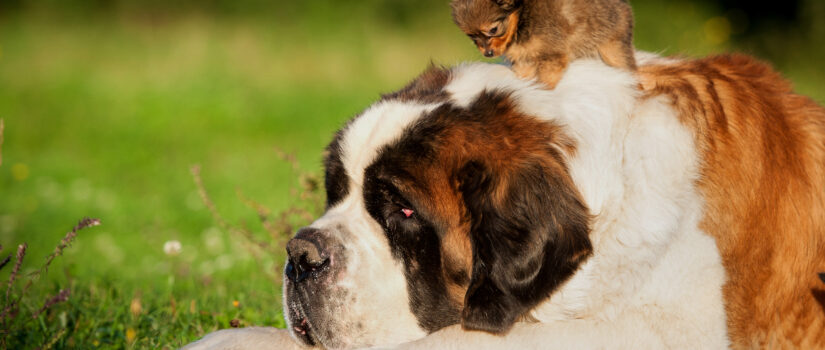When Can Puppies Meet Other Dogs?
***We know that Covid-19 has changed the way we socialize with each other so only do what you are comfortable doing, take precautions like wearing masks, washing hands frequently or using hand sanitizer, and social distancing as much as possible when you are socializing your pets***
The key to having a well-socialized dog is through healthy interactions as a puppy. Our dogs are most open to socialization in their young stages, meaning this time is vital for learning appropriate canine behavior.
In this article, we’ll discuss the importance of canine socialization, and tell you when it’s safe for your puppy to start meeting other dogs!
Socialization
Meeting other dogs and people outside of their home is extremely important for the healthy development of a dog’s mental faculties. A well-socialized dog is not only a happier dog but is a safer dog to have around humans and animals alike. Just as humans would struggle with social anxiety after being isolated, our pups are no different.
Not only can proper socialization help our dogs, but it can also bring us comfort in many situations as well. A socialized dog will allow for new visitors to enter your home, will make for a more peaceful stroll through the park, and can make many other public situations much easier. Socialization prepares our dogs for the outside world and makes them a more confident pup in the process.
Creating positive interactions will help your dog associate happiness with being around other people and animals. Practice makes perfect, meaning the more positive interactions, the better for our furry friends!
How To Socialize A Puppy
Before diving into the steps of socializing your puppy, it’s important to make sure you first consider their health. While you can try your best to be a responsible pet owner, you never know the health status of other dogs your puppy may cross paths with. Because of this, it’s important for your puppy to be fully vaccinated before going into a public setting with other dogs. This includes a distemper-parvo combination vaccine, as well as a rabies vaccine.
This can take up to four months, leaving owners at 16 weeks before socializing the puppy with other dogs. If you are set on socializing your puppy before they have received all 3 series of vaccines, you can contact local puppy training facilities to see if they offer any classes for puppies currently undergoing their vaccine process.
Once your puppy is fully vaccinated, it is safe to begin the socialization process in a controlled setting. A controlled setting can mean a public puppy training class, within the safety of your own backyard, or even with a well-behaved pup in the park while they are both leashed. It’s so important to have control in any socialization setting, meaning you should always have every animal on a leash while you are learning their responses to other dogs.
Tips For Proper Puppy Socialization
Since it’s important to gather as many positive experiences as possible for your furry friend, there are a few tips to follow when you are beginning the socialization process. Some proper puppy socialization tips include:
- Be sure to socialize your puppy with “safe” dogs. This means well-behaved dogs, dogs or puppies their own size, dogs, or puppies that you know are healthy, and with dog owners that respect the socialization process.
- Always allow your puppy to work their way up to new situations. For example, you don’t want to set your puppy loose in a dog park as their first socialization experience. It’s important to ease their way into this process by meeting one puppy at a time, working their way up to public settings, and giving them enough time to feel comfortable in the process before taking the next step.
- Always keep each dog on a leash during socialization. Keeping them leashed allows you to control the situation if either of them gets too rough, and can help to prevent negative experiences. Once two dogs become comfortable around each other, you can then remove the leashes.
- Be sure to read your dog for any signs of discomfort through their socialization. It’s important to remove your dog from the situation once they begin to feel overwhelmed, as this helps them decompress from the experience. This will also help to limit any negative experience throughout the process. If you aren’t aware of what a stressed-out puppy looks like, we’ll dive into the signs below.
Signs That Socialization Is Not Going Well
Proper socialization takes time, and it’s up to us to know when our puppies are becoming too overwhelmed in a new situation. In order to help you understand your furry friend throughout the process, let’s discuss some signs that tell you it’s time to remove your pup from the situation and give them a break.
- Cowering or clinging to your side
- Ears pinned down, tail tucked under, or other signs of fear
- Constant licking of the lips
- Constant yawning or yowling
- Avoiding people or other dogs
- Running from other people or dogs
- Snapping at other people or dogs
If your pup experiences any of the above signs, it’s time to take a step back and try again another day. Maybe you need to step back and practice with smaller interactions, or maybe your puppy is just overwhelmed from a day full of socializing. Our puppies can’t tell us how they are feeling, so it’s up to us to be aware of the signs of them becoming too anxious or stressed.
When To Let Your Puppy Socialize
Puppy socialization is a delicate process that requires patience and care. Be sure to review the tips we’ve listed above for safe puppy interaction, and you will have a well-socialized pup in no time!
Source:SitStay.com

